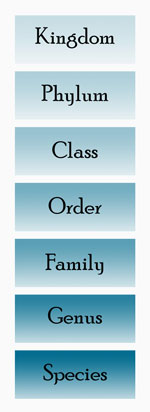
By Eric Collins, Expedition Co-Principal Investigator, University of Alaska Fairbanks
Life on Earth is extraordinarily diverse, with millions of creatures that are large, small, simple, complex, round, flat, dangerous, or cute. But how do scientists catalog this diversity? We can probably all recognize that grouping organisms into categories like “cute” or “ugly” may not be the most objective or useful, but what does make a good system of classification?

Hierarchy of traditional rank-based classification of organisms. Image courtesy of NOAA Office of Ocean Exploration and Research. Download larger version (jpg, 123 KB).
For hundreds of years, scientists have used visible characteristics – the shapes and sizes of organisms (known as ‘morphology’) – to organize them into useful groups. This process of finding distinguishing characteristics and sorting organisms by them is called ‘taxonomy.’
The smallest taxonomic group, containing organisms that are most similar to each other, is called ‘species.' Individuals in a species can be traced to a uniquely common ancestor. By definition, members of a species should only breed with other members of the same species in the wild. However, single species can still be very diverse; wolves and domestic dogs belong to the same species, for example.
A larger group of organisms that are closely related but don’t interbreed is called a ‘genus.’ Wolves and coyotes belong to the same genus, ‘Canis,’ but are separated into different species (‘Canis lupis’ and ‘Canis latrans,’ respectively) because they very rarely breed in the wild and have not shared a common ancestor for many thousands of years.
This system of naming organisms in Latin by genus and species was originated in the 1700s by a scientist name Carl Linnaeus and is now known as Linnaean classification.
Larger groups of organisms can be classified morphologically using more general characteristics. For example, foxes are merged with wolves and coyotes in a ‘family’ called ‘Canidae.’ Above family lies a grouping called ‘order’; the order ‘Carnivorans’ includes common carnivorous animals like wolves, bears, cats, raccoons, and marine animals like seals and walruses.
An even higher level, called ‘class,’ contains all mammals (‘Mammalia’), which are distinguished by a few very general characteristics, including the presence of hair and the production of milk. Ravens and frogs, for example, do not fall into this class because they do not have these characteristics, and instead fall into separate classes (‘Aves’ and ‘Amphibia,’ respectively) based on their own unique characteristics.
These three groups are combined, however, at a higher level called ‘phylum’ – in this case the phylum ‘Chordata,’ which also includes fishes as well as more unusual marine animals called salps and sea squirts.
Above phylum is a taxonomic group called ‘kingdom,’ which was historically considered the highest grouping. The kingdom ‘Animalia’ includes everything we generally recognize as an animal, and many things we might not, including organisms that live in the sea like jellyfish, sponges, and corals. Also included among the animals are thousands of species of microscopic organisms like water bears and worms that we rarely come across in daily life.
The other kingdom that is common in daily life is ‘Plantae’ (plants and some algae).
In the late 1800s, a third kingdom was added to include many of the organisms that had been discovered since the invention of the microscope. Because many organisms are microscopic, this third kingdom, ‘Protista,’ expanded rapidly. By the 1960s it became evident that microscopic organisms were much more diverse than previously believed, and many microorganisms from the Protista were split into two new kingdoms: ‘Fungi’ (mushrooms, yeasts, and molds) and ‘Monera’ (bacteria).
This “Five Kingdoms” organization of life has persisted in textbooks and may be the most well-known classification system still today. Yet, instead of morphological approaches, modern tools allow us to categorize life by a universal marker: DNA. This approach, called "molecular phylogenetics," has revealed that the "Five Kingdoms" is much too simple to describe the amazing diversity of life on Earth.
Learn about molecular phylogenetics and using DNA to classify organisms.